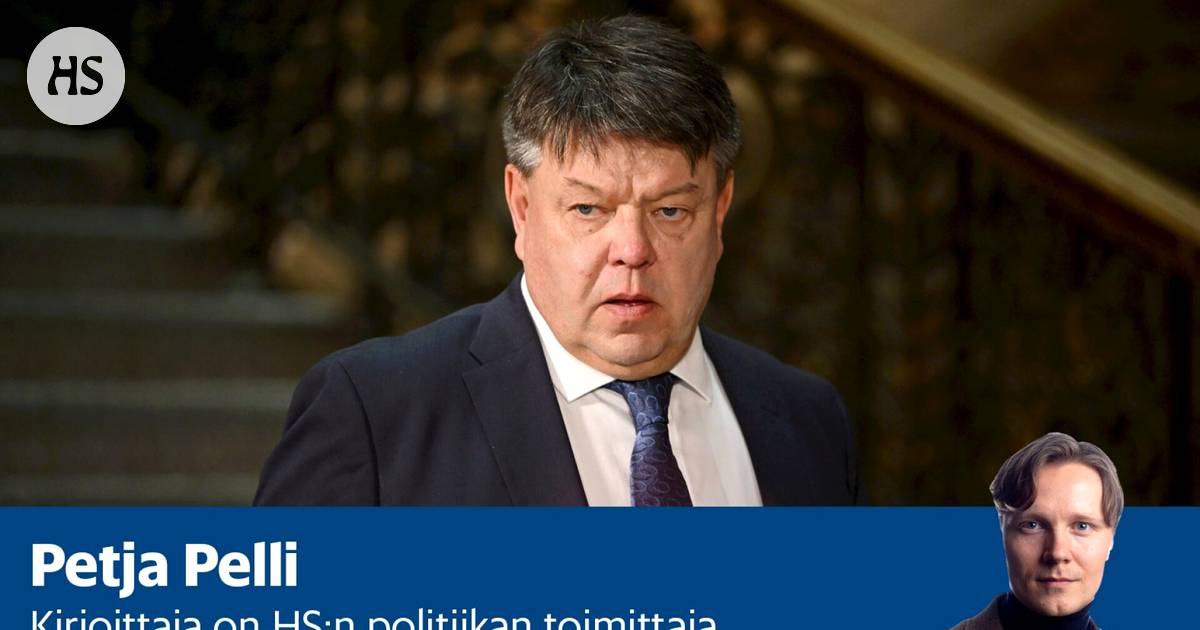The “proportionalization” of carbon sinks should lead to an emphasis on emission reductions, but there have been no signs of this from Säätytalo, writes HS’s political editor Petja Pelli.
World Secretary General of the Meteorological Organization Petteri Taalas gave a presentation at the opening seminar of the government negotiations on the Tuesday after May Day.
The same claim made the news as Taalas’ speeches before: in his opinion, Finland’s discussion on carbon sinks is an “international peculiarity” that forgets the big picture.
Taalas ignores EU commitments related to carbon sinks and emphasizes that Finnish forestry does not cause more permanent deforestation in the same way as, for example, happens in rainforests.
In addition to “putting carbon sinks to scale” – or precisely because of that – Taalas’ message also includes a more demanding half. It goes like this: man-made climate change is combated above all by reducing the burning of fossil fuels.
Taalas of this thought repeated to HS just before his visit to Säätytalon.
“Carbon sinks are definitely one part of climate change mitigation, but the most important thing is getting rid of fossil fuels.”
That is, breaking away from fossil oil, coal and gas.
Smoke billowed from the thermal power plant’s chimney in 2012.
Now about the government has been negotiated for almost five weeks. Have Taalas’ messages been heard?
Information has been received bit by bit, and the overall picture is missing. You have to be careful in the analysis.
However, based on what we have heard so far, it seems that the first half of Taalas’ message has been extracted: that is, that they did not swallow so not important.
At least there have been no signs of bold carbon sink actions in the information crumbs of the climate negotiations. Even during the elections, the quartet of government experimenters did not support intervention in the amount of felling or the opening of the Forestry Act.
It is also known that Säätytalo’s negotiators have asked the Ministry of the Environment whether the carbon sink target promised to the EU by Finland could be relaxed Due to the reduction of Russian wood imports.
Forming the board Petteri Orpo (kok) said on Monday that Finland will stick to its goal of being carbon neutral in 2035. The Climate Act will not be opened.
It’s a different matter, whether the government program includes actions that can be expected to achieve the 2035 goal. If Orpo assembles a board that sits for a full term, the term will end in 2027. By then, the most important target years 2030 and 2035 will already be in the lap.
Chairman of Basic Finns Riikka Purra predicted again on Monday that the 2035 target will not be met. He admitted that the goal of basic Finns’ politics is further alienated.
“When actions and climate policy become more pragmatic [käytännöllisemmiksi]then you can imagine that we are even further away from that target year,” Purra said at Säätytalo.
When Orpo states that the climate law holds, his right hand pulls in the other direction and Orpo lets it happen.
Säätytalo may very well have some cost-effective carbon sink measures related to peatland forestry or peat fields, for example. They just haven’t been told about.
It is well known that the coalition would like to cut wetland farming, which improves the carbon balance of land use.
How about that emission side emphasized by Taalas?
Basic Finns’ Purra stated on Monday that “gradually” weaning off fossil fuels is the goal of all parties in the Säätytalo.
So far, one significant action affecting emissions has leaked out of the negotiations. It is one that increases Finland’s emissions compared to what was previously planned.
It’s about of the distribution obligationwhich obliges fuel distributors to distribute a certain proportion of renewable fuels every year.
According to HS data, the obligation is being kept at a reduced level, i.e. 13.5 percent for the next year, after which the percentage would rise much less than Finland has previously planned.
Sanna Marini (sd) the government reduced the distribution obligation temporarily due to the energy crisis, while at the same time tightening the plan for the coming years. Therefore, the distribution obligation should have been raised to 28 percent already next year.
According to Finland’s current policy, the share should be 34 percent in 2030. Now Orpo’s quartet plans to increase the percentage during its season to only 23.5. In addition, the increase in fuel prices would be reimbursed to consumers, which would reduce the incentive to reduce driving with fossil fuels.
It is completely open where the hundreds of millions or even billions of euros required for fuel subsidies would be found. The whole structure can still fall.
In addition to gasoline, fuel oil and diesel, it is possible to fill up with bioethanol at the Helsinki gas station.
Basic Finns would have liked to lower the distribution obligation even further.
In any case, there is most obviously a hole left in the emission reductions of traffic.
In the EU regulation, Finland has committed to reduce emissions outside the emissions trading system by 50 percent from the 2005 level by 2030. Traffic plays a key role in them.
In 2022, Finland was accepted medium-term climate policy plan. Two possible additional measures have been recorded in it to achieve the traffic goal if nothing else helps. They are the national transport emissions trading and the kilometer-based taxation of transport.
It is highly unlikely that this foursome is pursuing either of those actions. Transport emissions trading would bring new costs to mobility, and Purra also repeated this week that Perussuomalaiset does not allow climate measures that weaken purchasing power.
On the other hand, kilometer-based taxation of traffic resisted in the HS environment exam three of the four parties sitting in Säätytalo. The Coalition, the Christian Democrats and the Basic Finns are all against a “the more you drive, the more you pay” type of traffic tax.
Actions may be allowed in relation to biogas and electric car charging stations and other support for the green transition of traffic. However, their effectiveness is uncertain compared to the distribution obligation, kilometer taxation and traffic emissions trading.
Ideologically nuclear power and smoothing the licensing processes for renewable energy would suit this quartet’s pie, even though the Basic Finns have reservations about Finland’s onshore wind power boom.
Of these actions, nuclear power construction in particular only helps with a longer delay. These are also not actions that would directly affect emissions outside of emissions trading, i.e. traffic, agriculture and separate heating of houses.
The negotiating sources did not want to comment on the state of emissions measures at the beginning of the week.
One of the negotiation sources answered the emission reduction question that “there is no money and the scarce money that is available must be used as effectively as possible”.
Another source only emphasized that there is of course much more on the table than the distribution obligation and referred to the name of the negotiating group, which is “Clean Energy Finland”.
Finland is used to patting himself on the back as a pioneer of environmental measures. The 2035 goal mentioned by Orpo on Monday is one example of that.
In their election campaign, basic Finns were surprised why Finland is overachieving in its greenness by striving for carbon neutrality 15 years earlier than the EU’s general goal.
However, that comparison includes an advantage, which is lost when viewed through the lens of Taalas. Finland’s carbon neutrality goal is timely precisely because Finland has assumed that it will preserve the large carbon sinks of its forests. For the last ten years, they have shrunk due to record felling and slowing growth. In 2021, Finland’s land use sector was the source of emissions.
If carbon sinks are left behind and the focus is on reducing greenhouse gas emissions, as Taalas wishes, the comparison will change. The emission reduction goal of the Finnish Climate Act is 60 percent of the 1990 level by 2030.
In the most natural reference countries, the target is more stringent: 65 percent in Germany’s climate law, 63 percent in Sweden’s climate framework and 68 percent in Britain’s national commitment. The target for the EU as a whole is 55 percent.
#Analysis #Taalass #advice #demanding #signs








